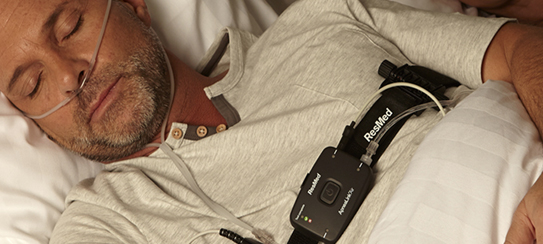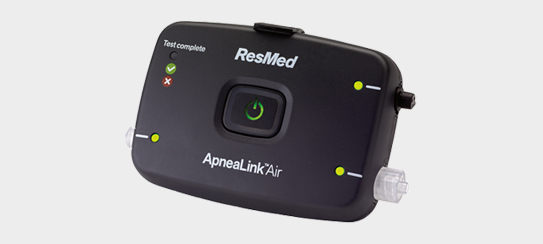Sleep Studies
ResMed's ApneaLink™ Air provides performance and reliability in our most compact, lightweight and easy-to-use home sleep testing device. A cost effective home sleep testing device, the ApneaLink Air is capable of recording up to five channels of information: respiratory effort, pulse, oxygen saturation, nasal flow and snoring.
Thanks to its new hardware, ApneaLink Air is easier to use for both patients and healthcare professionals, while continuing to deliver the high-quality you expect from ResMed.
Using this intuitive, cost-effective and reliable device can help grow your practice, increase workflow efficiencies, and also provide improved patient care, by quickening and streamlining access to treatment.

ApneaLinkTM Air

Ease of use The intuitive Start/Stop button provides one-touch operation and the test-complete light lets patients know when the evaluation has concluded.
Accuracy ApneaLink Air automatically analyses and derives AHI, flow limitation and snoring data. It can then automatically generate a simple, easy-to-interpret report with a colour-keyed AHI or Risk Indicators for the clinician to review.
Detail This convenient diagnostic tool includes differentiation between obstructive and central apneas, as well as Cheyne-Stokes probability detection.
The benefits of therapy
Why should I continue to use my equipment?
It's important to continue therapy even if it's difficult to get used to at first. Once you start to feel the benefits, you'll never look back.By starting and sticking with therapy for your sleep apnoea, you could be on the way to better sleep and better relationships. You may also find you feel more energised with therapy, which can help with motivation to start exercising. Losing weight can help improve your sleep apnoea condition too.1, Other benefits of sleep apnoea therapy is reducing symptoms of untreated sleep apnoea, such as morning headaches, forgetfulness, poor concentration and tiredness.2,3

References
- Romero-Corral A, Caples SM, Lopez-Jimenez F, Somers VK. Interactions between obesity and obstructive sleep apnea: implications for treatment. Chest. 2010 Mar;137(3):711-9. At the time of the writing of this manuscript, Dr Romero-Corral was supported by a Postdoctoral Fellowship from the American Heart Association. Dr Caples is supported by NIH grant HL99534. Dr Lopez-Jimenez is a recipient of a Clinical Scientist Development Award from the American Heart Association. Dr Somers is supported by NIH grants HL-65176, HL-73211, and 1UL1 RR024150, and by the Mayo Clinic College of Medicine.
- Wolk et al. Sleep-disordered breathing and cardiovascular disease.Circulation 2003; 108: 9-12.
- Palnitkar G, Zimmerman S, Cistulli P. Sleep apnoea in adults: identifying risk factors and tailoring therapy. Medicine Today 2012, 13(8):14-23










